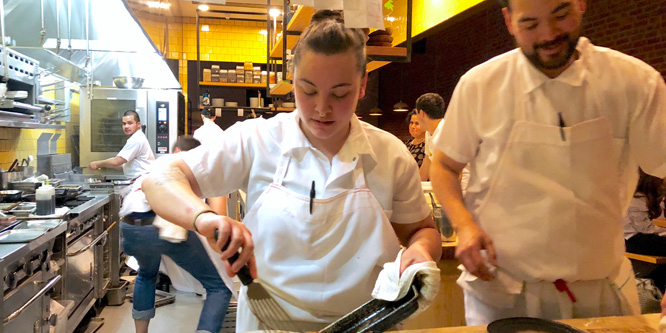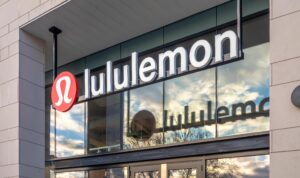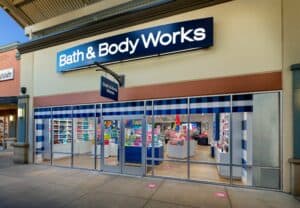
Photo: @MyDarlingClementine via Twenty20
July 12, 2019
Are cloud kitchens the next evolution of food delivery?
Cloud kitchens, which offer shareable cooking facilities to support food delivery, are just getting started but are already seen by some as a threat to restaurants and the overall grocery channel.
Also called ghost, virtual and dark kitchens, cloud kitchens are basically delivery-only restaurants. Similar to co-working spaces, the centralized cooking spaces gain efficiencies by being lined up assembly-like side by side. The sole on-the-go focus allows the businesses to build in further workflow efficiencies.
Space inside cloud kitchens can be rented by an existing restaurant to better juggle walk-ins and delivery during peak times. The bigger opportunity, however, is seen to be for entrepreneurs launching online-only restaurants and avoiding the front-of house labor and other overhead of walk-in restaurants.
Cloud kitchens offer rent savings as well because they can be housed in industrial buildings versus pricey street-facing locales. The rental kitchens come fully equipped with cooking equipment and utilities, and provide on-demand delivery services as well as apps to take orders and manage the process. The healthier margins versus eat-in restaurants promise to offset delivery fees.
Los-Angeles based CloudKitchens wrote on its website that, rather than a $1 million upfront investment required to build out a restaurant, cloud kitchen rentals can start at $20,000 and a two-month deposit.
For a monthly fee, renters may further gain marketing assistance and data analytics. Some believe the data on local tenant preferences to be gained by cloud kitchen providers will be more valuable than rent.
The trend is gaining attention because of major tech investors in the space, including Uber founder and ex-CEO Travis Kalanick, a CloudKitchens backer. Google and Amazon.com have also made investments.
Fans believe cloud kitchens not only address already strong growth in food delivery but may take it to another level in the years ahead.
“There could be a scenario where by 2030 most meals currently cooked at home are instead ordered online and delivered from either restaurants or central kitchens,” UBS wrote in a report earlier this year. “The ramifications for the food retail, food producer and restaurant industries could be material, as well as the impact on property markets, home appliances and robotics.”
- E-Commerce Turns the Tables on Restaurant Space – The Wall Street Journal
- Uber Tests ‘Virtual Restaurants’ Program – Bloomberg
- ‘Ghost’ Kitchens Play Bigger Role In Food Delivery – PYMNTS
- UBS: Online food delivery could be a $365 billion industry by 2030 — here are the winners and losers from that ‘mega trend’ – Business Insider
- A rare glimpse into the sweeping — and potentially troubling — cloud kitchens trend – TechCrunch
- The rise of the “ghost kitchen” could change the restaurant delivery game – The New Food Economy
- Deliveroo Pushes Into U.K. Provinces With Help From Amazon – Bloomberg
- Is Amazon really out of the restaurant delivery business for good? – RetailWire
Discussion Questions
DISCUSSION QUESTIONS: Do cloud kitchens have the potential to disrupt both the restaurant and overall grocery space? How would you access the upside and downside of the business model?
Poll
BrainTrust
Michael La Kier
Vice President, Brand Development - IGA, Inc.
Paula Rosenblum
Co-founder, RSR Research
Recent Discussions








“By 2030 most meals currently cooked at home are instead ordered online and delivered from either restaurants or central kitchens”… really?! This is an example of puffery by an investment bank to generate interest in a category and make headlines. There is a huge opportunity here, but it does not mean the end of restaurants or retail as we know it. The major winners will be the startups looking to break into the restaurant business who can now do so with low overhead.
The virtual restaurant idea seems to be in sync with the way foodie entrepreneurs are building their businesses these days in urban centers. Many use food trucks and booths at “smorgasbords”, food festivals, etc. to launch their brands. They may graduate to opening concessions in one of the emerging food halls where much of the support is provided and foot traffic is guaranteed.
Young businesses then face the huge step of opening a sit-down or counter restaurant space. Many fail at this stage. But a “cloud kitchen” offers another modest interim step in building the brand. One can imagine that many brands will be able to prosper while forgoing traditional restaurant spaces all together.
This may be a temporary disruption, but not necessarily a threat to restaurants. The concept may be one step too far into the fringe of restaurant service. Not a long runway for this concept.
Just like online retailing will not eliminate physical stores, I do see a definite and growing place for these kitchens, or “custom commissaries” as I call them, however they won’t stop people from cooking at home nor eating at restaurants.
The U.S. online restaurant delivery market is estimated at $20+ billion by 2023, and online services like Yelp attract millions of people looking for restaurants. I find it entirely plausible that this virtual restaurant model can work. Working in midtown Manhattan, I see dozens of lunch restaurants that undoubtedly pay enormous rents, that are deserted 22 hours a day. Restaurants would simply swap rent expense for marketing expense, and might find that they come out ahead.
Sounds like a life of endless Top Chef episodes!
There’s no doubt that Uber Eats and GrubHub/Door Dash have disrupted the food industry. But faced with an array of restaurants I know, why would I order from a restaurant I’ve never heard of?
On the surface it’s a combination pop-up store/food hall, but I just don’t think it’s gonna work.
Ghost kitchens have a host of benefits to entrepreneurs, who can adapt menus easily, incur few marketing costs, keep staff expenses to a minimum, and reach new audiences with ease. A husband and wife team in Sarasota started theirs six months ago and have found great success. And customers win.
This is another iteration in the evolving food landscape. CPG fueled grocery store purchases are competing with data-driven meal kit startups for dining share of spend. They in turn compete with restaurants that are increasingly offering healthier and more varied eating options and looking for ways to lower their fixed cost structure.
Cloud kitchens will increase competition and accelerate the ongoing disruption by further lowering entry (and exit) barriers while increasing consumer options. Success will require innovative use of data to identify underserved consumer tribes, combined with trend setting high quality menus and low cost of customer acquisition – a very tall order.
I love the business model. Consider the desire for meal delivery to grow for consumers. It is the same cultural trend that drives online in every way — convenience and time saving.
Delivery by restaurants is an ancillary business. For cloud kitchens it will be the primary business. The kitchen will win every time.
It will take some keen marketing, but restaurants don’t do any marketing to speak of. It will not replace people’s desire to go to a restaurant, but will replace current delivery and home cooking.
It’s easy to see how the “shared services” model can be applied to restaurants and foodie entrepreneurs.
Home food delivery is an interesting business model in a state of change. To a “street restaurant” who uses Grub Hub for selling/delivery, they have all the costs of the physical plant/store, but Grub Hub is taking upwards of 30% of the selling price of each order. I can’t see how that is sustainable where margins in a restaurant are too thin for that. Now take away the physical presence and go to a ghost kitchen and maybe there’s a way to make ends meet. I wouldn’t be surprised to see some of the “grub hubs” offer the kitchens as the next step.
Like most things we discuss on this board, this isn’t an all or nothing business model; some want food out, some want food in and there’s plenty of room for both models. I agree with the comments on “brand” which indicate that to be successful with either model, you probably need to do both.